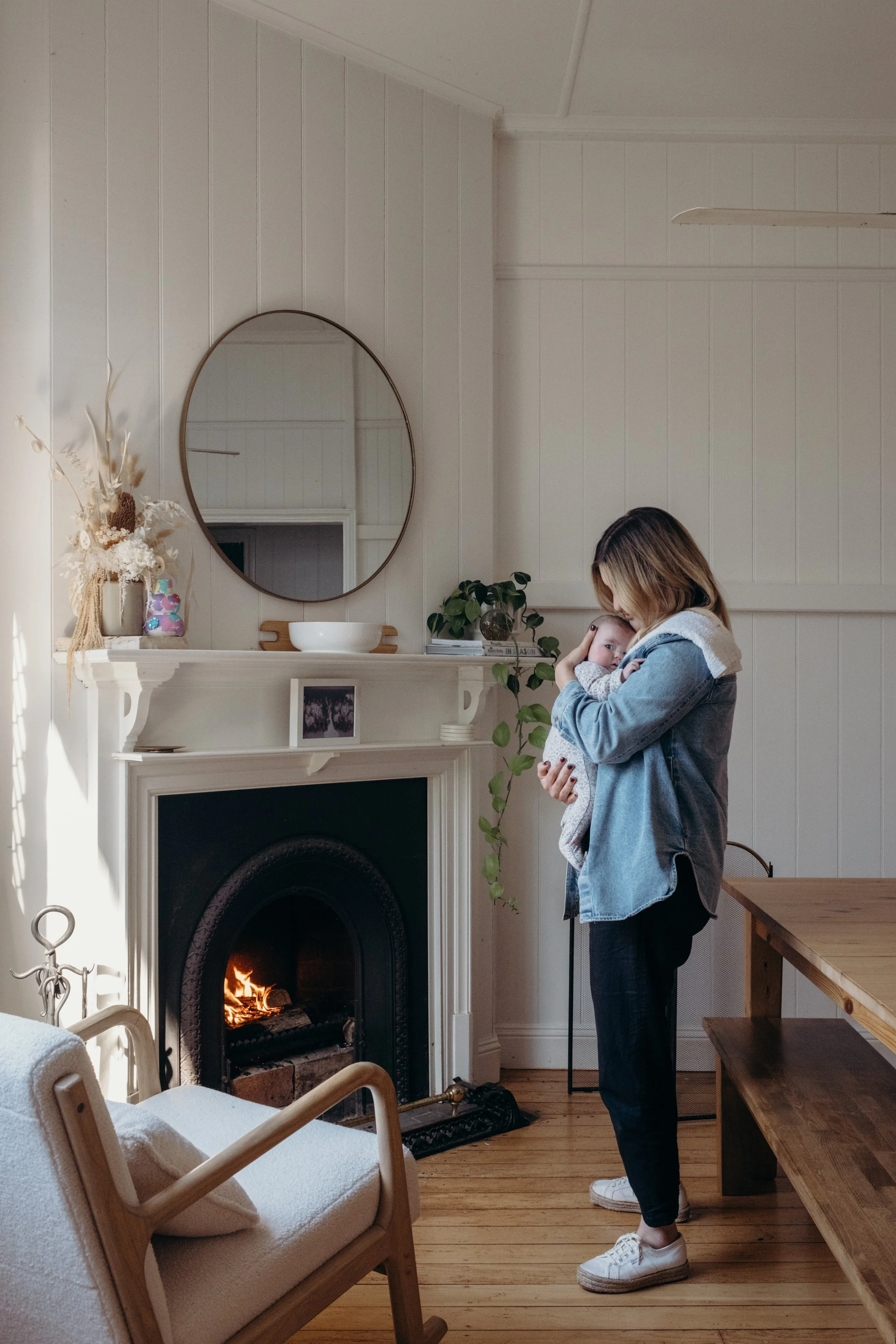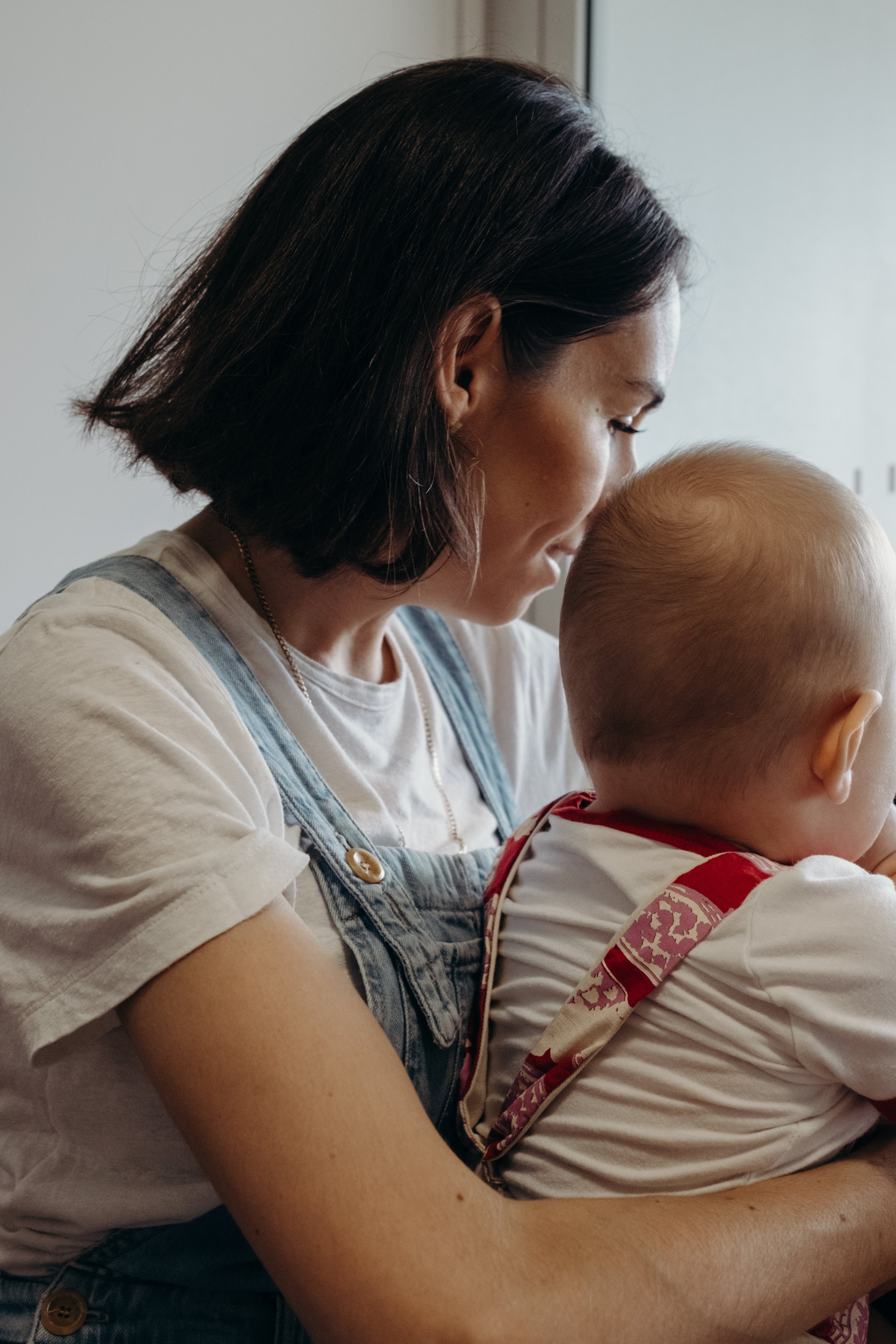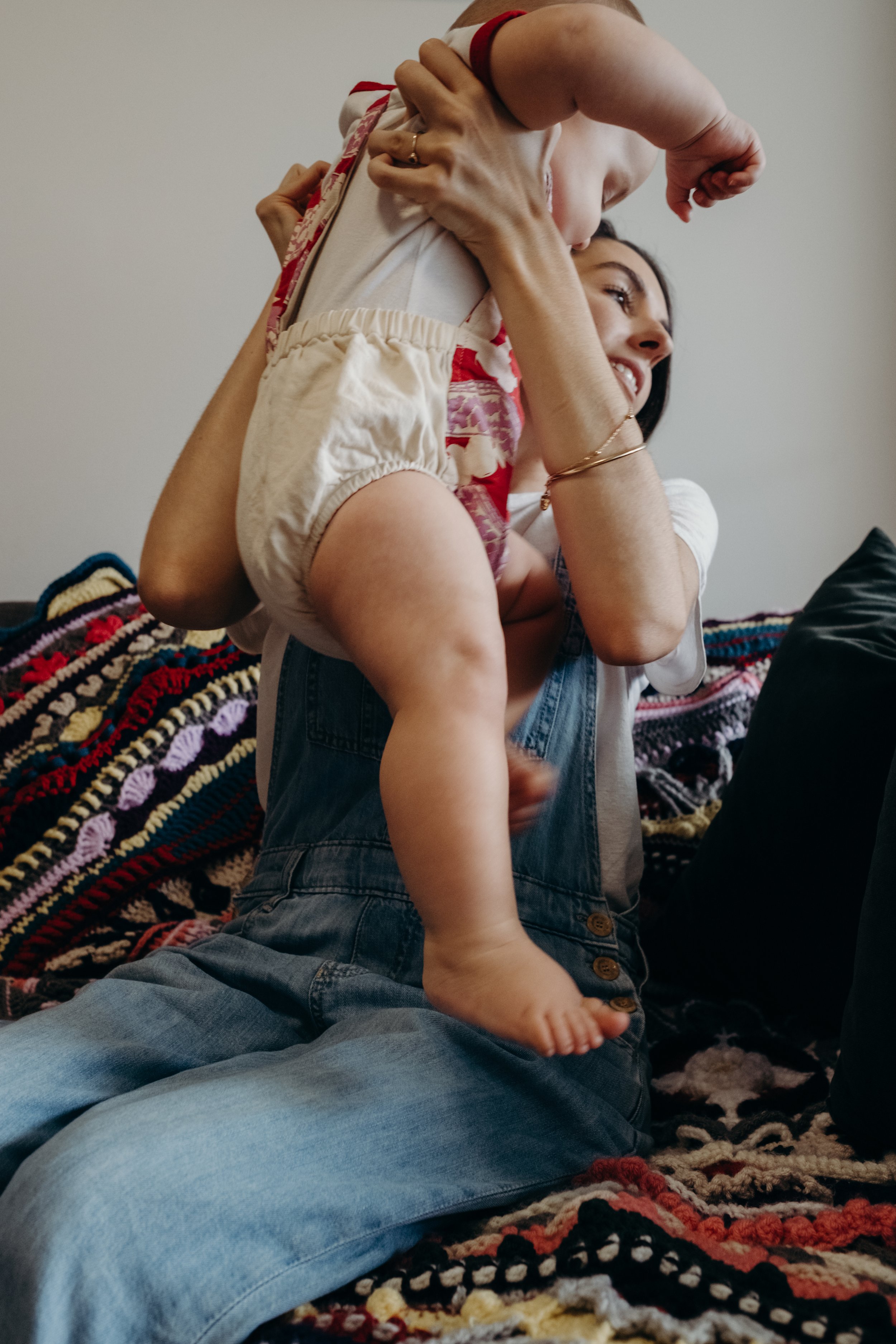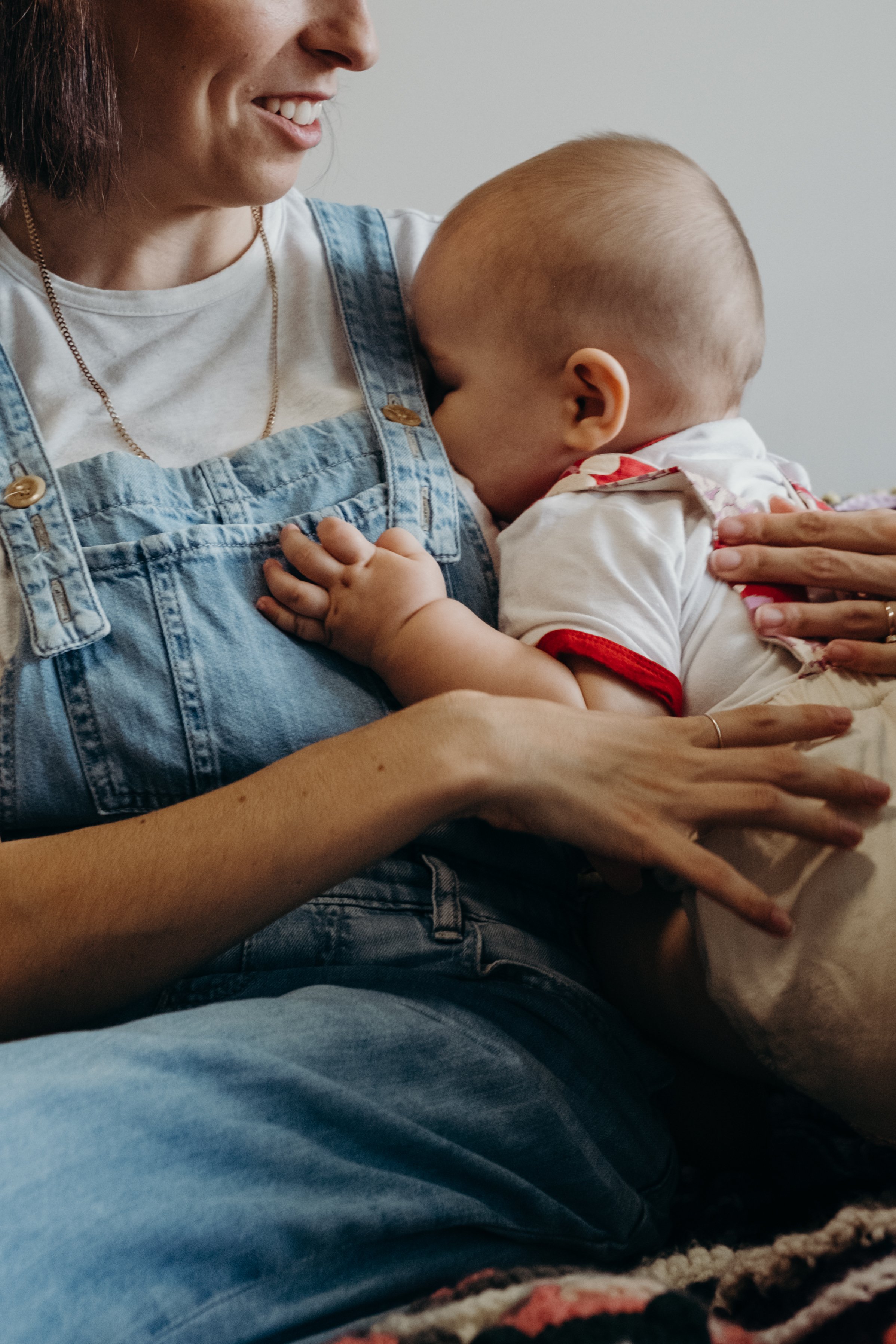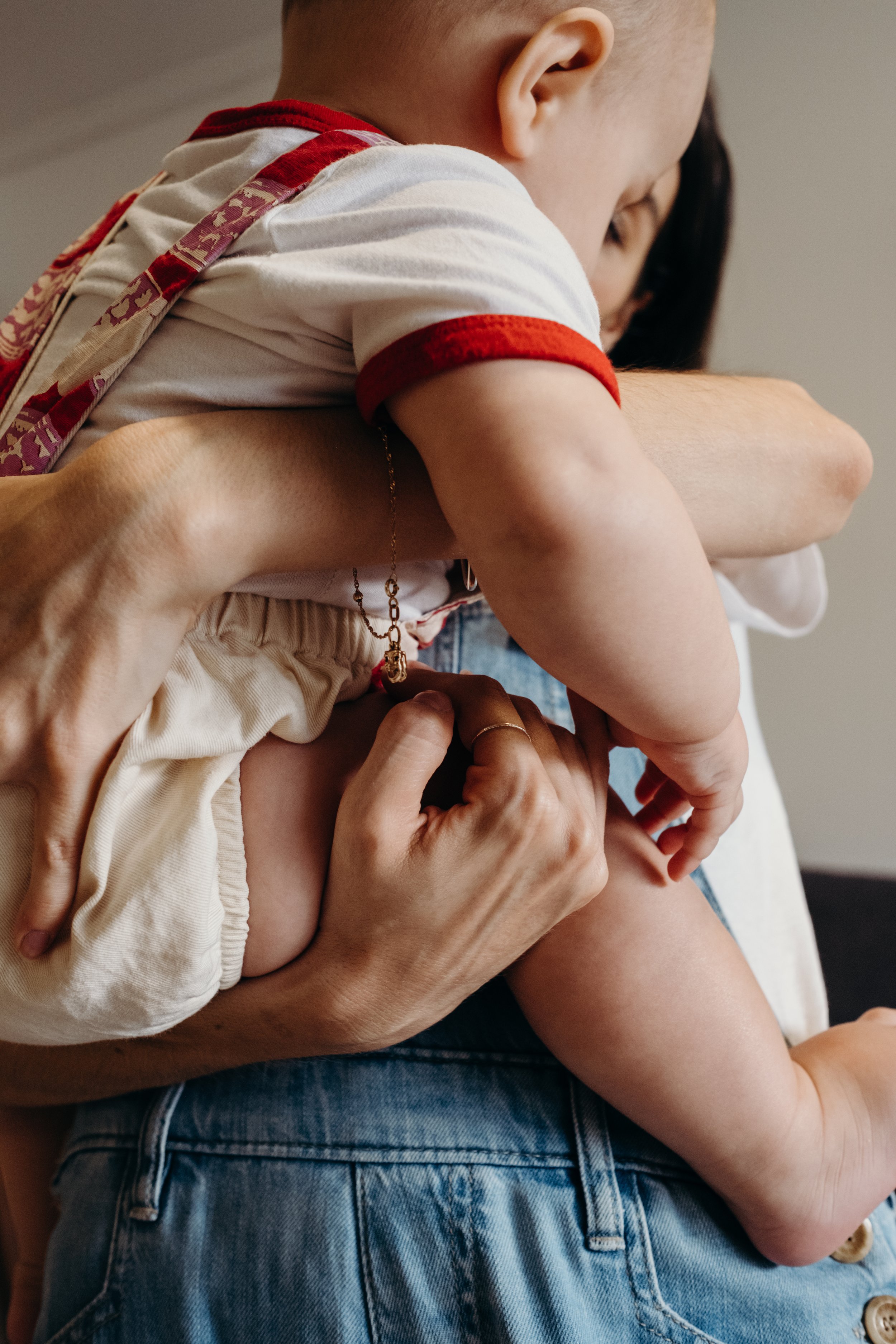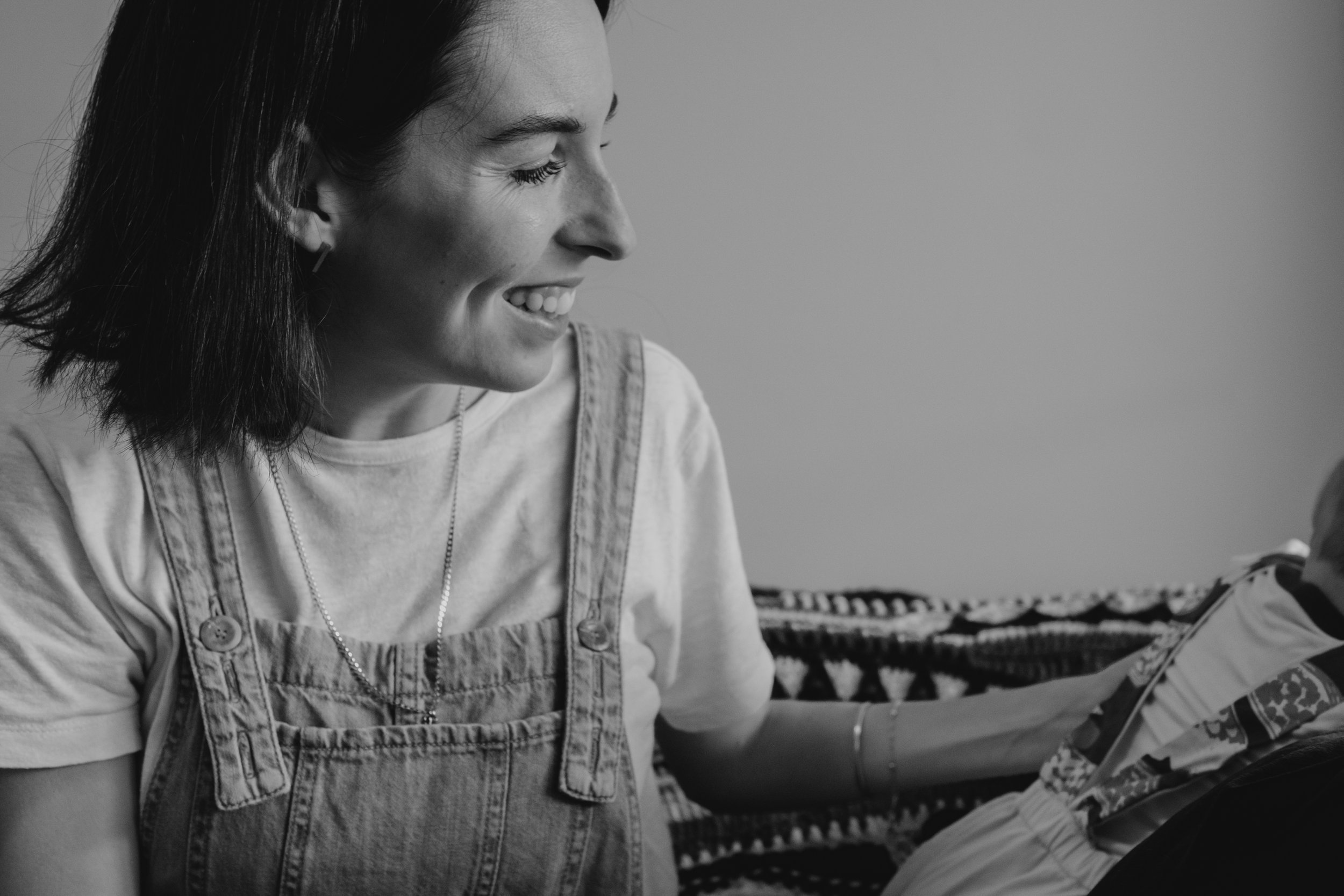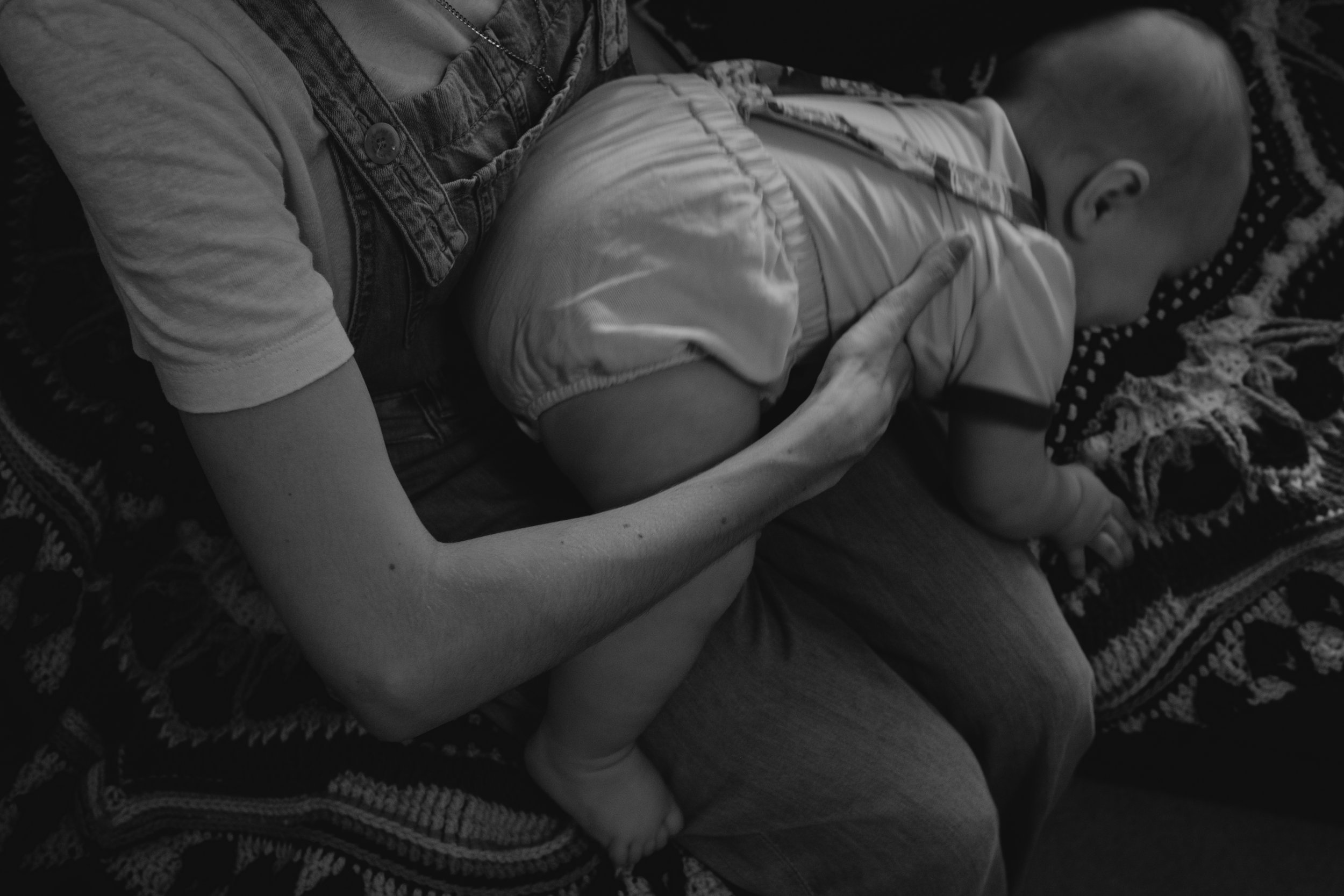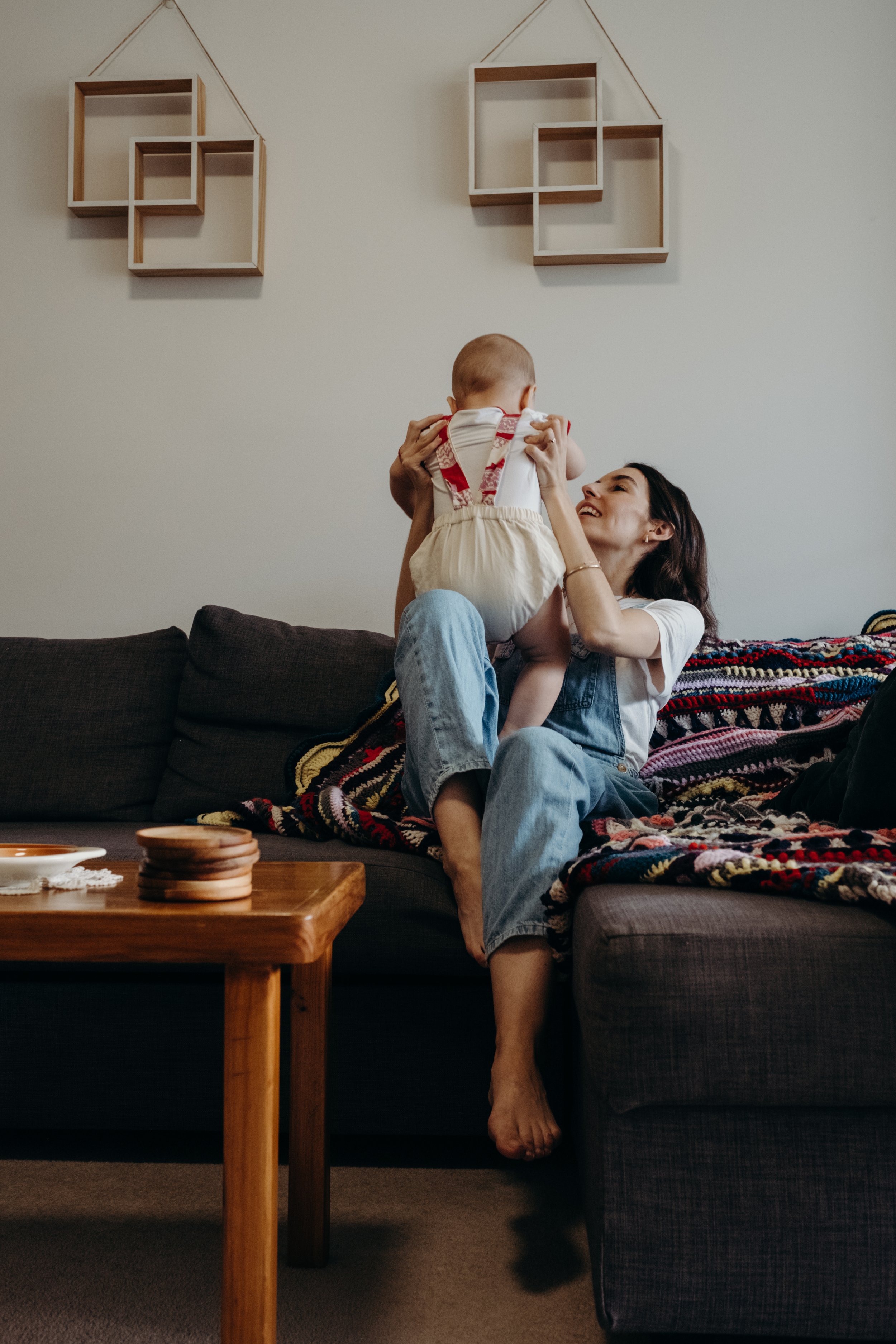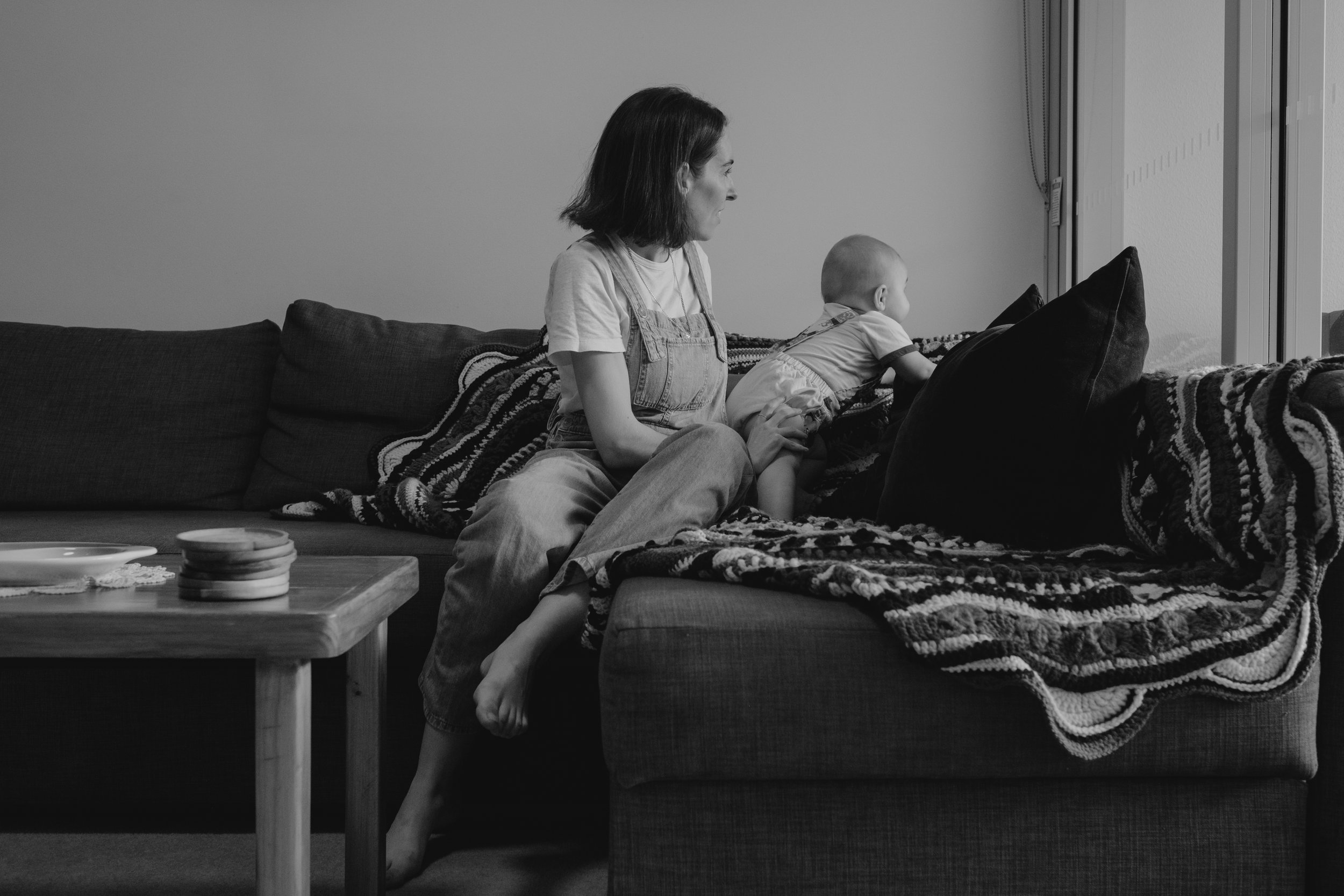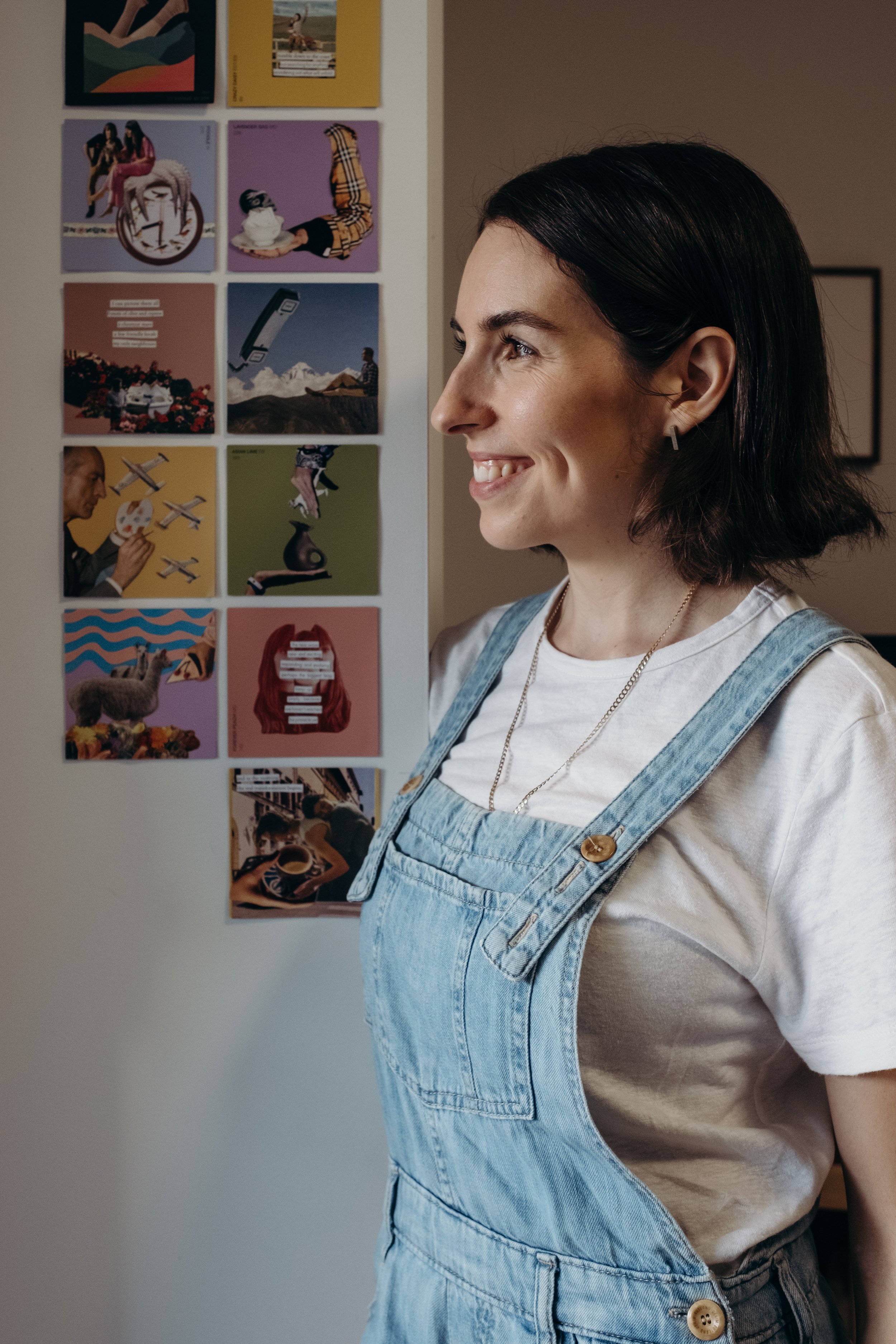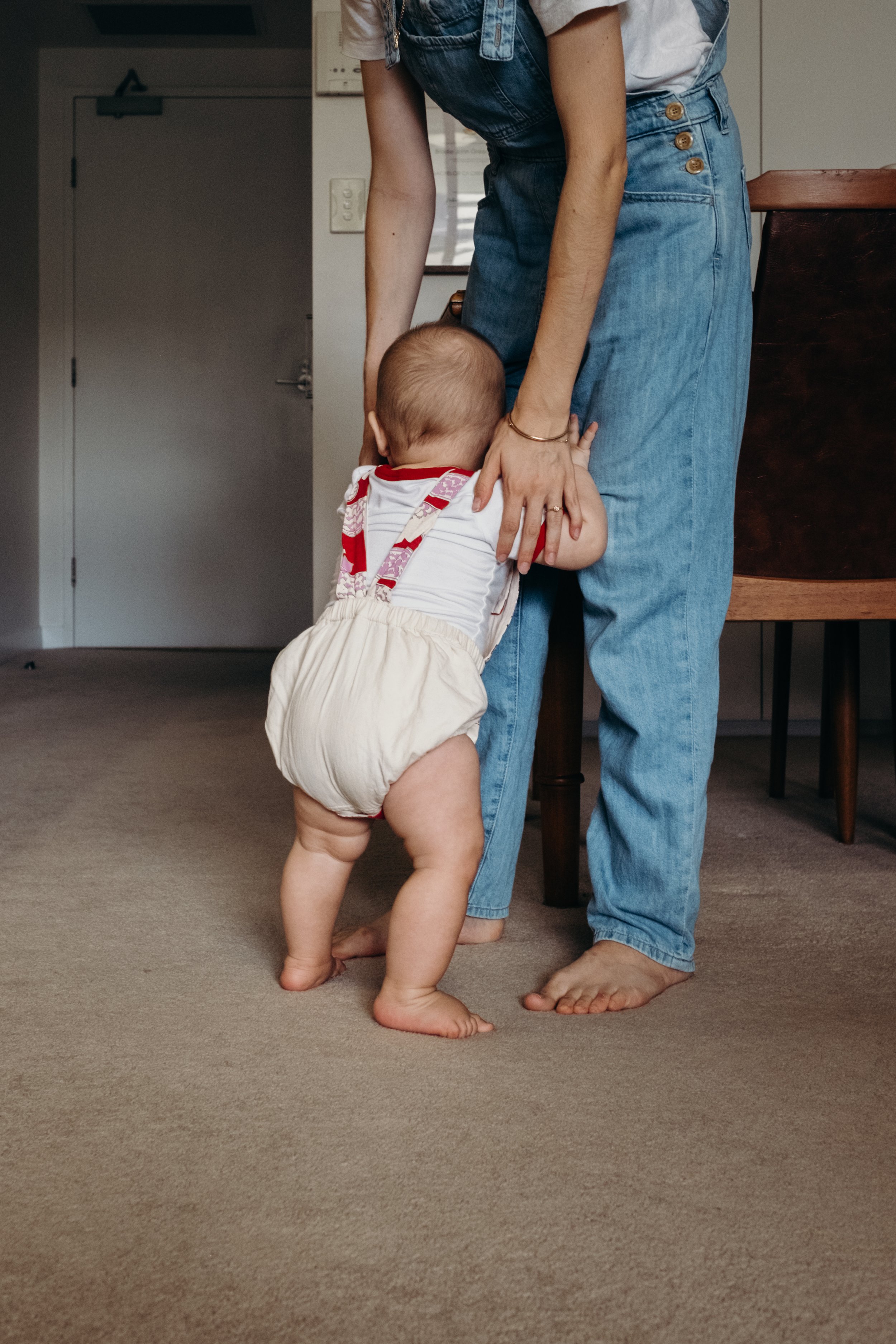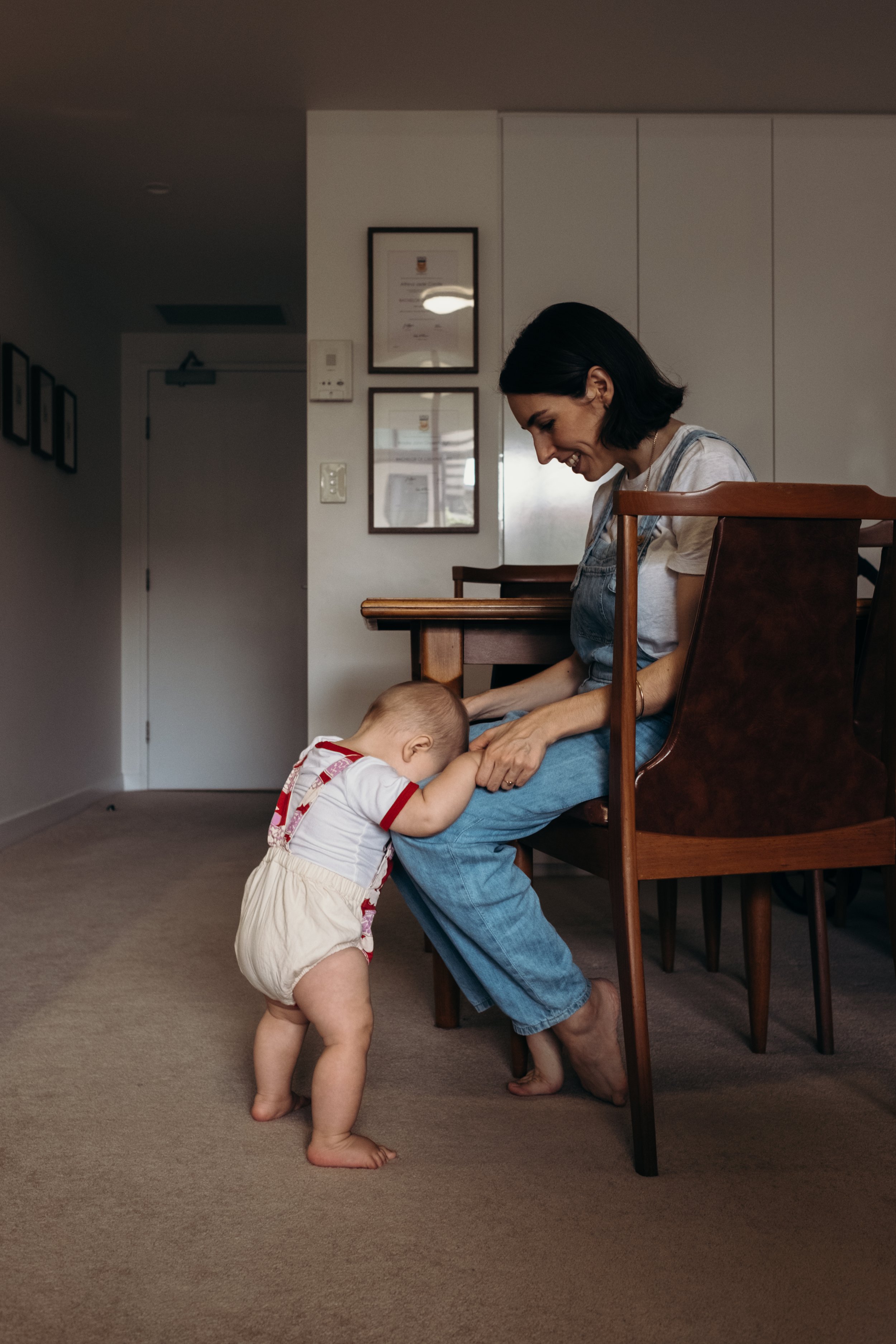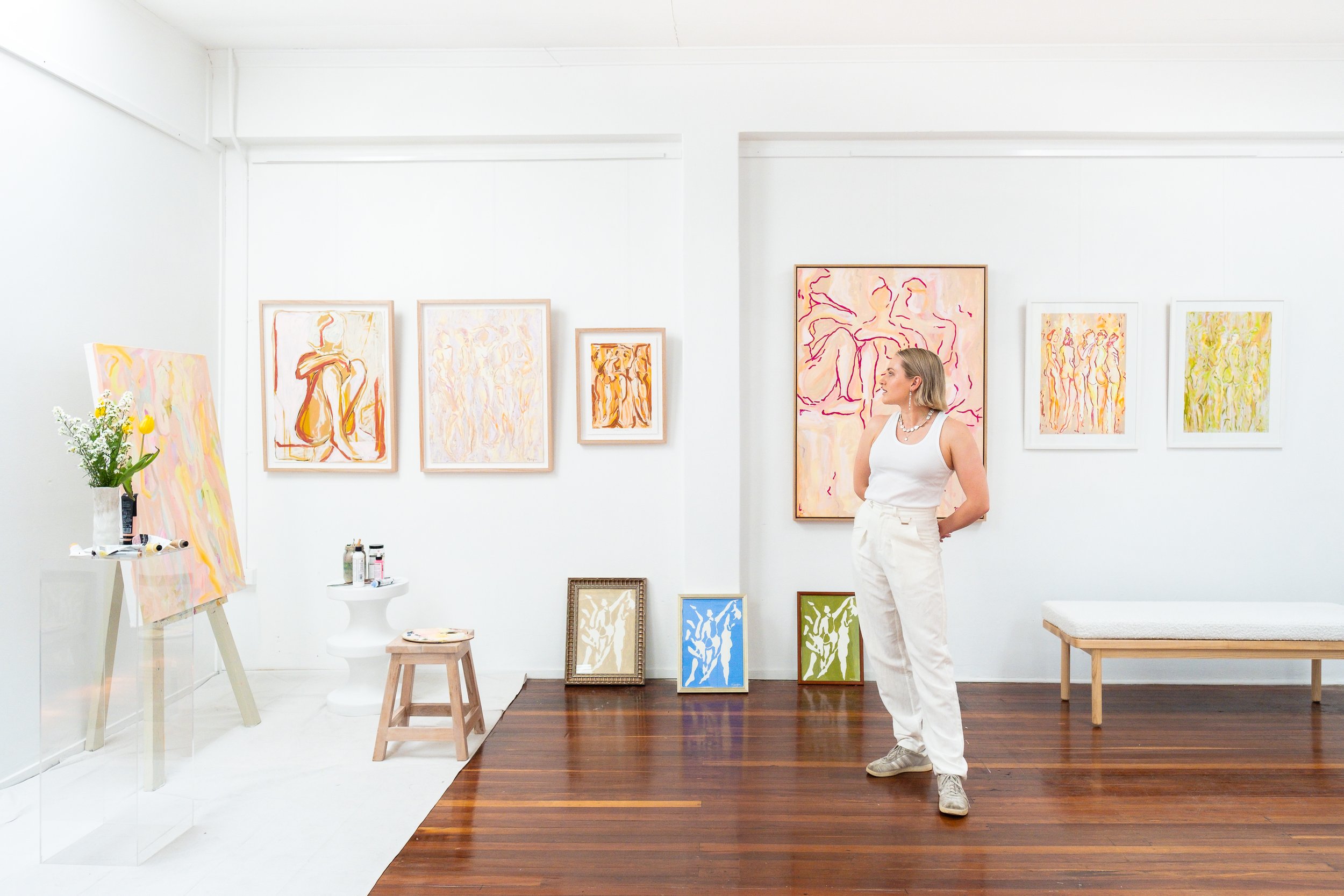In conversation with florist, Emily Richardson
founder of Ruby Lane Flower Co, Emily Richardson, chats about accidentally finding floristry, how she balances babies with business, and returning home.
as founder of go-to Toowoomba floral destination, ruby lane flower co, and mother to Mac and daisy, Emily has gracefully adapted to each change that has come her way. From working out where to call home, and scaling her still growing business, emily has learnt the power of putting down roots.
This feels like a lovely full circle moment. One minute we’re in primary school together, and it’s 90s birthday parties & sleepovers, and now we’re running creative businesses & raising babies! You have Mac & now Daisy. How are you?
I'm good. It's been an adjustment, but I think I struggled more from zero to one, whereas one to two feels like you're already parenting, you're just parenting a little bit more. Maybe Mitch has to parent a little bit more (not that he's not already) but I think he's found it more of a struggle because he's had to have Mac where I've had Daisy. But I feel like the adjustment is making sure both are happy and dealing with the mum guilt of, are you neglecting one or the other? But besides that, I feel like our lifestyle was already in that routine, so I don't know. I feel good. I feel a lot more settled this time. This time I knew what I wanted to do with work as all those decisions were already made with Mac. I know more about how I want to parent, so that's felt a little bit nicer, whereas that felt a bit more stressful the first time around. You're kind of inventing the wheel the first time and seeing what works, whereas this time, I know what works for us, and it's just adding another child into the mix. So I feel like it's been a little bit easier to get our head around this time.
That’s really good to hear! We know you as an exceptional florist, curator & the founder of Ruby Lane Flower Co. With roots in Toowoomba but with time spent in Brisbane, you have returned with your brand to build a family & future in Toowoomba. What brought you back?
So I moved to London at first. That was my first get-out-of-Toowoomba moment. I moved there for six months and then came back to finish off uni and start working. But then I came back to Toowoomba and was like, no, I've just come from London, I need something bigger. So then I moved to Brisbane, and that was where I met Mitch and got married. We decided together that maybe we were ready for something different. So we were going to move to the coast, and then right as we were about to move, we had a going away party and realised we couldn't afford the coast! But we'd already told everyone, so we were like, well, where are we going to go?
We started sort of looking back in Toowoomba. I always thought I would never come back, but we were back for just one weekend visiting my parents, it was Autumn so there were all the fallen leaves in Queens Park. It was really beautiful. The weather's cooler, and Mitch loves the colder weather, so it was more him being like, “This is actually really nice. We’ve never really considered it, but we're looking to start having kids. so is this the sort of a place that we should be going with more affordable housing?”.
So we moved here sort of on a trial period, and I was still like, “I don't know…” I think everyone who grew up in Toowoomba has that “get out of the bubble” feeling, but in coming back, I think you just appreciate the good parts. Also, in coming back as an adult wanting to start a family, you can see all the benefits which you don't see when you're 18. So yeah, we just came back.
There was also a lot of creative things happening at the time, and I think that really drew us in. So the trial period pretty quickly became a permanent decision, because we just started getting involved in little things around town. It felt nice to be building something, not moving to a big city that's already got all these creative programs established, but to feel like we could actually make a difference here, or be a part of this community. To help build it from the ground up sort of thing, I mean.
And really you have. You came back at quite a pivotal time in the landscape of small business and creativity in Toowoomba, and very quickly made quite an impact. Can you tell me about your journey into floristry & how it all began?
So when I came back from London, I was about to finish my Bachelor of Communication, so I was doing PR, and then sort of realised that I didn't want to do that. I thought maybe I'll do a degree in nutrition, whether I work as a dietitian, or whether I just incorporate it with the communication degree and do public health or something. So I went back to Brisbane and finished that and started working as a nutritionist. I just didn't think of myself as a creative person when I was growing up, and I felt a lot of pressure to be stereotypically smart and do science. I did well at school, [so I thought when I finished school] that meant I had to do something with that. That society equates that to being… I don't know. So while I did that, I would love to go into the flower markets in Brisbane. I would just go the markets and get flowers for myself, and started making up more little arrangements around the house.
A friend was getting married and trying keep it quite cheap, and she was like, “Do you want to do my wedding flowers?” And so I did that. And then it was really Mitch who, because he had worked creatively for himself since he graduated school, said, “Yeah, great. Do it as a business.”
And I was like, you can't just do that! You can't just go and become a florist. And he was like, “Why not? We're together. We're fine money wise. you can have a break if you want to try it and If it doesn't work, you have things to fall back on.” We didn't have kids so it really was a risk free time but I'm not a risky person. I really struggled with that - thinking I could just go out and do it. It was so ingrained that you have to study to do it. [So I was thinking], do I have to go back and study floristry? But I just didn't love the modules and how it is framed at your typical TAFE, so I just started doing it really casually. I was still working through the week and then on Saturdays, I would just make up “Posies of the Day”. They just started selling at first to friends and then we made a very official website. I remember the first time someone rang and bought one that I didn't know. I was like, “Oh my gosh. This is amazing, it’s not just my friends trying to be nice. Someone actually bought it!” And then Saturdays just started booming. I pulled back one day at work and did them on Fridays and Saturdays. And then it was Mitch [who said that I needed to] go the whole hog and see. So I just quit my job and started doing it, and it really it was such a blessing. It really took off straight away or it was enough to make me feel like it was going to be okay. So I did a little bit of training with another florist so that I felt like I did have more base skills. And then, yeah, just kept it going.
That's amazing! You and Mitch are both wonderfully creative people and creative business people. How is the juggle with now two full time businesses and two little people?
Yeah, it is tricky. I think one of us is always doing something. When I moved back [to Toowoomba], he [Mitch] was doing a lot more weddings and his business [castle and crown] was still on the coast at the time, so he kept that going. I moved back and tried to get established here. When covid hit he lost his weddings, so he started doing something else, and I started my shop. That was more steady, and so he had time to work on his business. Then we added the kids! Since then it's like, just keep the businesses going so that we can have kids! It does feel like we're always trying to let one person focus on things I guess. Even now, I'm on maternity leave and I've got employees there [at Ruby Lane] who can keep it going. That gives Mitch an opportunity now and he's building something different - a studio space in town, [precinct studio], so now that's our focus.
Having the two kids, there's not really enough space for us both to be full time parenting, or full time at home and building businesses. It has to be a bit of give and take. He helps me with my stuff, and then I have space in my life to help him with his. So we are very collaborative, I would say. We are always in each other's pockets and know what is happening. he's sometimes down at the shop, and I'm sometimes up with him. It’s very convenient that his businesses are now above mine, which is really nice. Now he's upstairs, so it'll literally be him coming down for coffee, and then I can pop up and see him, and I'm hoping it'll be good with Daisy.
To me, that sounds like a dream. And you're now on the second iteration of your bricks and mortar store. Can you tell me about Ruby Lane now, compared to the beginning and how you're feeling about its constant evolution?
I think it's nice, it keeps it fresh. at first wanting to focus on weddings, and then we were looking at having kids so we were like, oh, would it be easier to have a shop and really focus on the daily delivery side of it? And so then we built the shop, and it happened to be just when covid hit, so I lost weddings anyway. So I was like, well, let's focus on a bricks and mortar store. And so we did that and built it, and it meant that I could have staff. And so when we had Mac, I could leave, and the business could keep going. So I was really grateful for that, because when I was doing it at home, or when I was just doing weddings, it was just me. to have the opportunity to still be able to earn an income from it, and be off for the amount of time that I want to be off is great.
But it just got to the point [in the old space] where a friend wanted the space that we were in, and asked if we would consider moving. there was no pressure, but we'd always wanted to add coffee, and so I was like, great! Maybe it's an opportunity to move. So then we went and saw the Rowes building. It was just perfect. It had the courtyard, it had a workshop space that we can use for our workshops. It had something like a coffee window, and so it was just the perfect space to then add coffee. I think each time it's changed, it's good for business. Like it's good for the business to keep it fresh, but I think it's also good for me to keep it fresh. It just makes you get really excited about it and sort of reconfigure how you do things and gives you something else to focus on. And I like that part of it. I like doing different elements of it.
I can see you like working on the business as much as you like working in the business.
Yes, but always both. I'll never just do one.
You’ve been able to step back from the in person running of the business to grow your family. How have you found the transition from being on the floor to behind the scenes?
I think that's where sometimes Mitch and I differ, because he's very much like, “Oh, wouldn't it just be great to have staff in there doing the flowers, and you just work on the business, and you can be behind the scenes and building it up and doing the marketing.” But I was like, “Yeah, I did a degree in marketing and PR, and I hated it and I didn't want to do it.” I love working in floristry. I really love the hands on element. I love talking to the people that come in and buy them. I love seeing people getting flowers. Even with the deliveries - we have couriers now, but I will always still do a couple of deliveries a week, because I love it. I love seeing people's faces when they get flowers. I take Daisy down, I’m on maternity leave really, but I'll take her down. I just hang out. But also, maybe because it is a nice space, like flowers are always nice. It's set up to be beautiful, it's meant to be peaceful and it's meant to be joyful. That is what giving flowers is. and the gift of giving all the time.
Motherhood changes us in so many ways. How are you feeling now compared to when you moved back home? Have you found motherhood has changed how you view your business at all?
I think the best advice I got when I was having kids was, “Don't decide when you'll go back to work until you've had the kid.” Growing up, I always thought that I would stop working and I would have children, and I would be at home all the time. Then I really loved my job, and so then I was like, actually, will I go back to work full time after having the kids? Now, I love striking the balance between the two. So until they're in school and fully, you know, away, I think I've set a really good balance of part time work.
I mean, part time work when you're in your own business is full time work, part time being there a couple of days a week, and then being at home and getting to do fun activities with kids. I love the balance of going to those things with them, having holidays with them, having them home with me, and then other days where they're in daycare two days a week and I get to go and just be fully in the business and be a part of it. So I couldn't decide that until I actually had them and realised I really loved both, and I couldn't handle doing both, or being away from both but yeah, you can't decide that until you're there.
Now I'm so grateful that I did set up the store as I can be away and set my own hours and be with kids. I can still go in anytime I want and be in that world as well. And present. It's about being present in both halves, which is tricky. There are definitely weeks where, like this week, the kids were sick, and it got to the end of the week and I was like, I did not talk to the staff at all, like I was not there, and thank goodness they kept running it well. We've got really good people in place. But it definitely feels like I probably didn't give enough to that side this week. But that's the balance.
How does it feel raising Mac & Daisy in the city you grew up in?
It's really nice. There's little things like when we go to the Queen's Park, there's the same slide that I went on when I was a kid. I'm such a nostalgic person and I love feeding into that nostalgia. Things like finding photos of things that were the same… and so I really enjoyed that. And I think I'm so comfortable with what is here and the things that I enjoyed, but then there's also so much here that wasn't here when I was a kid. And I think that's enough to make it feel different, to make it feel exciting and like I'm living a different life. I'm not just repeating it.
There's a lot more sort of going on here than when I grew up. And that's what keeps it exciting as an adult too, that there's more to discover all the time.
How has your house shaped how you live & work with your little people?
We get very drawn to farm life, like having chickens and being out of town and having the space. But I think the benefit to being right in the city while they're little and we don't have a big backyard is, we can get out at any point and go down to the park, or we can quickly drive to a cafe, or we can go to the library, or we can do all those activities really easily. So while we don't have a lot of the space that we would desire, having a smaller house where the house is really comfortable, and it's so close to other parks and other things, sort of fills the gap in the meantime. So we debate it all the time, and now that our businesses are both set up here, it's like, do we need to be right in the city because it’s so easy, and we can duck home really easily. But I think our dream is to still live a little bit further out and have chickens and ducks and goats.
What’s next for you and Ruby Lane?
I think at this point I’ve built it to a point where I'm happy with it. I can keep it going, and have kids and get them sorted, and get them into school and just have stability. So I think for now, the focus turns to Mitch and what he wants to do and how he wants to build. And at the moment, that's really exciting, and so we're working on that stuff. But I think for me, I’m just enjoying it. I know Mitch is more of the let’s grow, let's build, let's do stuff type of person. I'm more like the slowpoke, but I think sometimes that stability is nice because it does allow you the lifestyle that you want. And for me right now, that's being with kids and getting them sorted.
It’s been an absolute delight to be with you this morning. Thank you so much for having me.
Thank you.
for more from emily, you can find her at @rubylaneflowerco and @emilyrich_.
photography & words by morgan smith for morgan journal.
In conversation with writer, Athina Greenhalgh
Sustainability writer, Athina Greenhalgh, shares all things freelance, motherhood, creativity & beyond.
Until recently we’d known Athina Greenhalgh as a writer for Outland Denim, capturing audiences with sunlit campaigns and educating denim diehards on sustainable manufacturing. Since then she has opened her scope as a freelance Sustainability Copywriter, working with brands who are determined to make an impact. In 2023 Athina & her husband welcomed their boy, Ávgoustus to their family, which also includes Gabby the Bearded Collie. I made tea for us in her kitchen, and Athina generously shared all things freelance, motherhood, creativity & beyond while we watched Áv explore his little world.
How are you having navigated the journey from working full time, to making the decision to go freelance, to becoming a mother? How did that all come about?
I had felt my brain being pulled in a couple of different directions before falling pregnant. I adored my job and the brand, but I also had this idea that freelance might suit motherhood really well with the flexibility of that. So eventually after thinking about it for a really long time, made the call that that's what I would do. But then a few weeks later, we had a positive pregnancy test. So I didn't really intend for both things to happen. I thought maybe I'll have like a little run up with freelance and then you know, find my feet with it and and then fall pregnant, but it just happened at the exact same time.
In some ways at the time it was really chaotic and quite frankly, dumb to do. But then, on the other hand, it forced me to learn a lot of lessons very quickly. I couldn't muck around figuring out how freelance work best for me. I just had to figure it out as soon as possible.
How does it feel going from working as part of a team on one brand to being a team of one? And now with many small, purpose-led businesses coming to you!
I think what surprised me at first was how isolating it can be. Because even though over COVID we all sort of got used to working from home or solo working, you’d still have a team member on the other end of a phone call, or a Slack message or an email, and you have a shorthand and a rapport.
Now it’s a different relationship. And it's the building up of that rapport again, so it doesn't feel so transactional and so you don't feel so isolated. That was really tricky towards the beginning. As part of that, we naturally want feedback on our work. And I think when you're in that very familiar team environment, people's confidence in your competence comes in formal and informal, direct and indirect ways. It’s reiterated so much throughout the day. You know, like the, “You’re a legend!” after you’ve sent something through. Things like that. Whereas I had to get used to it that with freelance, you don't have that shorthand and that rapport straight away with people. So you're going, did you actually like it? Did I actually do a good job on that? Am I a fraud? [Laughs.]
That's also true when you’re at home as a new mum. And for you, those things happen simultaneously. We don’t always get feedback on our mothering (especially from you right now Ávgoustus, you’re a bit short on words).
How was it navigating new motherhood with a new business? Were you able to take a break from work or did you feel you had to be on while you were learning to be “Mum”?
A bit of both. I was definitely “Mum” first. I had a couple of months off which was great as I’d been working part time up to [having Áv] as well. And then I think in the third month, (I was still mostly having maternity leave), but I took one of my monthly clients back on and just started gradually building it up from there. I was in a really lucky position that my partner could consistently have one to two days off work still on parental leave while I got used to it.
You were able to share the load fairly well?
Oh, yeah, definitely. We shared the load heaps! We’re really lucky that my partner had an excellent amount of parental leave, so we were able to share it. And I was able to slowly transition back into work. So now we're sort of in the next phase of that transition of him back full time. So it's changing again for me now.
How are you liking working with different impactful businesses now that you have been Athina Greenhalgh, Writer, for a year?
It’s great! It's an area I'm really passionate about personally. I naively thought last year was for learning, or the pregnancy phase was for learning and then by this year I'd know what I'm doing. [Laughs.] But yeah, it's been really great. I'm so lucky that everyone I've worked with has been so amazing. Where I'm at now is working out specifically what people's needs are in terms of writing in the world at the moment. There is so much writing that can be done, so I’m trying to be specific.
Probably the other part of learning this year, while having less time, is that within that space innovation and research changes so frequently. So that's something I've had to accept and pivot away from [and work out] how I can still be of service to my area and my target industry. But I accept that those projects surrounding research or communicating research or communicating broad scale impact and keeping up to date with what's happening in the industry - I kind of don't really have capacity at the moment to be as across that as I used to be. So I’m going, “That's okay!” How else can I help?
You write from such an emotive place. The human experience is loud and clear within your work. Do you feel that has been exacerbated by what you have experienced in early motherhood?
Yeah, it definitely has. I mean, obviously in ways like setting up time boundaries and all of that sort of thing. But the work itself probably has, though I haven't really thought about it specifically in a tonal sense, or in an emotive sense. There would definitely be subconscious influences there. But I think I've always been really terrible at writing for myself, which I guess we all are in a way, but I couldn't start a journal for myself. I've always said that I don't feel like I have anything to say. But to write for other people, I find that a lot easier.
You’re an interpreter of sorts. You hear what the rest of us ramble on about and managed to make perfect sense of it.
Yep, I'm much better at that! [Laughs.] I can't work out what's happening up here. [Laughs, pointing to her head.] But other people's words I can do.
Well, on that note you've been working with wordplay through your collages, which, as a viewer, has become an obsession of mine. It seems to be an obsession of yours as well. Where did the wordplay start? How did that element of fun sneak in?
It is, honestly, my flow state. I need to schedule collage time in, which I'm not always great at, but I need it. My friends and I love to get together and collage, and I literally got to the point with some of my magazines that they were so torn up and no images left, I was like, I'll just play around with cutting out the words. And as I said before, I kind of need a brief to be able to write. I can't just journal my own thoughts. This was a really good way of going well, the words are already on the page, I'm just editing them together. I always feel like it doesn't make any sense but then other people read it and they naturally switch into this poetic tone of voice and I’m like, [laughing] you fool, those are just random words I cut out, but people have their own interpretations of them.
Every one takes something from what you have put on paper. It’s giving us a new way to read something and it does feel profound. It’s probably bizarre to hear that word associated with your flow state requirement.
It probably subconsciously helps me in my work writing as well. Just that expansion. Getting out of routine thinking, routine vocab, that sort of thing. Up until this year I’ve been really bad at incorporating any kind of play into my work. I've always had fun at work, and been a bit of a class clown at work and laughed a lot at work, but never used play as a tool. I’ve forgotten where I heard this, but I heard someone speaking last year or maybe earlier this year, on the power of, for lack of a better term, networking. But really just getting out, particularly as a freelancer, and seeing other people. And so it started with that kind of thing. Just getting out and trying to expand myself, more than just being a person behind an email. And following joy.
Whenever I was feeling like, “Ooh I’m not really getting as much work as I would like.”, I would try to book in a time to go see people in a sort of networking, but casual sort of setting. I think that the collaging has been a similar vibe to that. I'm just trying to follow the flow and follow the joy and the play and the fun, and trust that everything else will come. I'm glad that you enjoy it because for so long I was [wondering] are people are going to think like, “Athina has lost it! She really mustn't have very much work going on if she's posting her collages. Oops, did she mean to post that?” But in my head it goes. So I'm glad it’s perceived that way as well.
Everything you have just said feels like a reflection of freelance life and motherhood. To follow the joy and the play, and the importance of stepping outside of your bubble. Have you found that the two have gone hand in hand for you fairly well, so far? How have the challenges and the joys presented themselves?
I feel like I'm still in a bit of a teething period in terms of optimising the hours of the week that I have available to work. What can I get done in that time? But overall, I feel like the work always gets done. It somehow gets done by the deadline. You just go what tools do I have in my toolbox? There's the library, we’ll go to the library. There's grandparents, we’ll ask grandparents for help. There's no one way. Somehow it's gotten done for me anyway. I think, as I said, booking in that creative time has been really important to me. That I don't always find easy. Because even though my partner's incredibly helpful, and if I was to be like, “Hey, I'm gonna spend an hour collaging or out and about tonight.”, he'd be like, "Yep, sweet. I'll handle it.” But it's still hard to do. Because if you're at home, doing your creative flow state activity, you can still hear your Bub in the other room. You might be tempted to go, “I'll just go help”. But yeah, I feel like it's working at the minute.
That's great. there would be many , myself included, who lose sight of that outlet or time for themselves. It's I think it's incredible that you have found that so early in your postpartum journey. It aligns so well, with both work and home.
It's getting there gradually. There are definitely things that I haven't gone back to. I haven't gone back to ballet, things like that. But yeah, getting there gradually.
A while ago you started cooking and learning Greek and became The Olive Oil Advocate for a little while? How did that come about?
Gosh I think that came from me wanting to learn Greek, and also learn how to make some more traditional recipes. But then very quickly losing sight of the fun of that, and going, “And also will turn it into an Instagram page - [laughs] and I'll gain a following.” For my brain at least so that's a really good quick way to have me immediately lose interest in it. So then it was, “I don't enjoy creating content for this. I just enjoy the cooking part and the learning part but I'm not enjoying the content creation part." And that's something that my friends who collage with me, we talk about all the time. “Oh, we could do this! Wait, hang on, stop monetising your hobbies.” That was probably the first realisation for me, that if I was to go freelance that writing would be the thing that I would do.
So I've definitely fallen off the bandwagon in terms of learning Greek. Maybe trying to teach Áv will encourage me to jump back on it. I still love cooking. I hate collecting content of me cooking so you're probably never ever, ever going to see it again. But the Instagram page is still there because I can't bear to lose the name Olive Oil Advocate, because I feel like it's so perfect. It's just sitting there collecting dust at the minute in like the the Instagram account idea graveyard. [Laughs].
I think I have four or five of those as well. So you're not alone! All of these projects have such similarities. There is an element of learning, of play, of words. You are forever surrounded by language and words. And something that makes you slow down, whether it be cooking, or collaging. But from what I've seen, there is always a common thread, which has been beautiful to watch.
I've never noticed that through line. So that's again, you need some perspective I guess sometimes to see these things.
You do, but I can also see how everything has culminated in where you are now. And I can't wait to see my next. You’re obviously having fun writing for these conscious, ethical businesses!
I guess just naturally with freelance imposter syndrome likes to creep its way in. But I've learned from again, getting out and talking to people, that is a natural byproduct of freelance life and working on your own. Now that I can better identify that I am really enjoying it and always was but it was just yeah, that would occasionally creep in. But I'm loving it. Some days I'm like, “Oh, what I did today was learn about cool brands with cool products doing cool things and I might buy one of those when I've submitted this blog.” That's really fun. Because it would be what I enjoy doing anyway.
It's wonderful to see and I know you feel like you're juggling it all because you are you're doing an incredible job.
Thank you.
For more from Athina, you can find her at @athinagreenhalgh.writtenby.
photography & words by morgan smith for morgan journal.
In conversation with artist, Hello Chelsart
Chelsea Baker, better known as Hello Chelsart shares her creative journey through academia and motherhood to Seedpod Queen.
Chelsea Baker has studied many things, thoroughly. But it was her seaside collecting of natures byproducts that led her to take out her creative energy painting seedpods. The rest is very pretty history indeed. Now a happy inhabitant of my own regional home town, Chelsea splits her time between motherhood & co creating with nature. Working with an educated understanding of biomimicry, and cultivating a generous online community, Chelsea is opening our eyes to some of natures most architectural miniatures. You can read all about her artistic evolution right here.
I’d love to hear about your journey through academia, now motherhood & returning to your art. Can you tell me why you decided what to study & how you have arrived where you are?
When I was at school, the guidance councillor asked me, “What are you good at?” I would play around on the computer and I was really good with Photoshop. So they suggested Graphic Design and I didn’t really think about anything further. I did really enjoy studying that, but some of the subjects were really really good, and some of them were really shit. The ones that stood out had me making magazines of architecture and advertisements for an eco village. My dad suggested I do Architecture. Dad & I would always go on drives to look at houses as that’s his thing. He has a building background. So from there I went into Architecture.
While I was studying my undergraduate degree we did an assignment for Landscape Architecture. It was at this point that I went to talk to my convenor as I wasn’t too sure if main stream Architecture was what I wanted to do. I was wondering if I should look at Urban Planning or Landscape Architecture, but was told my uni did nothing to do with landscape. Which was a bit odd because my final assignment was working with a Landscape Architect, and I loved it! While working on that I would go to the beach to study plants, and I’d be collecting things. A ridiculous amount of sticks actually.
I have a collection of driftwood if you would like it.
Oh I’d have it! But I’d have to get the ok from Michael. It is in our marriage vows though. He did promise not to say anything about me collecting things.
Ha! Smart woman.
So I’d finished my undergraduates and was in a state of “What should I do?”. My lecturer was like, “Why don’t you do your masters, do a lot of study on biomimicry and anything that’s different to you.” One of my assignments for my masters was on Crystal Waters near Maleny, which is all about natural living. You could build anything out there & no one would bat an eyelid. I went into the funnel of reading all about sustainability. I loved what I studied but it wasn’t in the main stream.
Due to Michael’s job opportunities we ended up here. [Toowoomba] It was close to Mum & Dad, I’m not really a city person & we’d done the beach stuff. It was a real fork in the road, to either [apply for] Graphic Design work at the uni or be a Graduate Architect here. I did put in a couple of architecture job applications but I found if they ever got back to me I’d ignore it. You know what I mean? When I was offered a Graphic Design position at the uni I felt much more confident to give it a go. It was a great way to get my skills back.
At home Michael would be asking, “What are you doing with all this stuff?” One day I finally painted on a driftwood stick & gave it to my boss. He was like, “Did you paint this?” To which I said yeah of course, and that he could have it. He said, “You should do more! I’ve never seen anything like this.” He really pushed me to do that and I’m really thankful to him because if he hadn’t, I probably wouldn’t have continued. So I gave him that stick. He said, “Are you sure? It will be like the unsigned Van Gough. I have her first piece!” Which was quite funny.
After that I’d bring pieces into work. Seedpods I’d collected on walks with my son, trying to survive [early motherhood]. Then I started collecting more and more and more. And started painting them. I didn’t ever think about it as I’d always just had them there. My family were saying I should do something with this, so I started a page.
And here you are, selling your art.
Yeah, though I don’t think of it as trying to sell. I think that’s what I struggle with. Having to make sure to make money. It’s lovely because people want to buy, but I don’t always want to sell them. I’m hoarding them. Recently I had a lovely lady over asking about buying various pieces. I had to say I’d allow her to buy one, but to give me time to let the other ones go.
Separation anxiety?
[Laughs] Yep. The first one that I sold was to the owner of a local yoga studio. When I went back to see it months later it was weird. It was mine but it wasn’t mine anymore. It’s a weird thing. That’s why I’m still hoarding. And that’s why I’m doing the prints. I can accept letting the prints go.
Your print collection is a huge step for your business. How has that process felt? And how have you turned your seedpods into prints?
I think the prints have only literally come about because people, this sounds bad, but because people have been hounding me to buy a seedpod and I’ve been quite stubborn with not wanting to. I’ve worked with others and now I’ve started taking photos, arranged flatlays (that’s an old uni skill, product flatlays) and because they look “real” people have been ok buying that. But the prints are only because of me being stubborn.
Well that worked really well. Maybe you should continue being stubborn.
Anything I do has come from people asking. I’ve been asked when I’m doing textiles as someone would like to buy a dress. Then a friend who makes dresses asked, “So when am I doing a dress for you?” Then I had my best friend ask for earrings like the ones I’m wearing. But I just had them made for myself! So a lot of these creative things I just do for me, and people are amazing because they like and want that.
And you’ve been cultivating quite the online community. As your work & platform are growing, how do you feel?
It surprises me honestly. I feel good because I think the difference between my art & maybe any other art is that people send me seedpods. It’s an interactive community. It’s not just that people are viewers. I’ve had a lady from America send me seedpods. Portugal, seedpods. They’ve asked me to paint them.
Do you send them back?
I sent the lady from Portugal her seedpod back. I’ve also had some come from the UK.
There are such unique qualities to each species. Would there be seedpods from around the world that you couldn’t otherwise get your hands on?
I will say we’re incredible lucky in Australia. We have about 85% of the best seedpods. Being Australia, being arid, our seedpods are made to last. Whereas the majority of places, not all, but most others have quite brittle or frail seedpods. Or they break down really easily. Whereas some of our seedpods have to withstand fire. Like that one there [gesturing to seedpod collection] only opens when burnt. I think that is so beautiful, almost like a phoenix.
So that’s what I love about my art. People send me things. Most of them don’t want anything, even though I offer to pay for postage or freight. But they just want to see what I do with them.
When you pick a seedpod, where do you start and where do you draw inspiration from for your unique patterns?
It’s really hard to answer, that question. [Laughs]
Sorry you probably get it a lot.
No! It’s just that I have so many seedpods. You can ask Michael, I’ll just be staring at them. Just looking at their qualities and their textures. They’re all unique but they’re also very alien. Half of these things you would have seen, but because they’re on a tree or they’re discarded you don’t necessarily take the time to look at them.
There are definitely some here that I remember standing on at some point, or think that one’s hit me in the head before. But the majority of what you have on your desk, if I’ve seen it before I couldn’t tell you where or when, or what tree it comes from.
Isn’t that refreshing to go, “We have this? And I’m just not looking hard enough!”
It does come to me, the designs. I struggle to paint anything too rigid. There have been times when I’ve gone out of my comfort zone & tried something geometric but biomimicry is all organic, always flowing. I think that’s why I like circular things. Anything geometric has too many rules.
Do you think your study of biomimicry is directly responsible for you engaging with seedpods in an artistic way, rather than just appreciating them in their raw form?
I don’t think I would have taken the time… That’s why I don’t think they are wasted degrees. I would have just thought they were pretty. But because I had to study biomimicry in all the theory, all the principles, all the examples and actually do architectural designs on them I learnt how hard it is to replicate nature. How hard it is to make something look “natural”. One of the principles within nature is odd numbers for example, which does translate to design. So most of the dots or the lines that I paint will be grouped in odd numbers. I think by having that foundation I was more comfortable doing this because I knew what looked natural. But it’s very hard to make something look unordered because humans by nature put things in boxes. So you’re fighting your instinct.
Personally I sit back in awe and watch as your practice grows, and you’re growing as a mother at the same time. You’re growing your business as well as your husband’s business.
I’ve wanted to give up many times!
How has becoming a mother changed or inspired or directed you?
I can say 100% the only reason I have done as much as I’ve done is because I’m a mum. Not because they give me inspiration, no. They give me, “You need to get this done now otherwise you cannot.” With uni assignments for instance, I could not do it until last minute. Now really you have 10 minutes where they go down everyday, and you will have 10 minutes. You have to get something out. Usually that pressure would be too much, but I used to do creative exercises where I’d grab a seedpod and one paint colour or three paint colours, think of dots, and that was all I was going to use.
I did that so often that now I don’t feel the pressure. It’s almost like, you’re lucky to get this brief moment in time so let’s use it. Whereas before having kids I’d have the whole day. I wish I was this productive before kids, but I don’t think you have that drive.
It’s nice to hear everyone’s take on that question, because everyone has felt motherhood in a different way.
I think when they get older it will be nice. I collect seedpods with my son and can actually see now his interest in it. It brings a different level to it. If we’re going for a walk he’ll make me stop, get a seedpod that I haven’t even seen. He’ll be like, “Seeeed pod. Mumma. Paint? Nice.”
That’s beautiful!
Yeah! Or I’ll have brought prints home to show Michael and he’ll go, “Wow wow Mumma draw!”
I get the sense that your painted seedpods are only one part of your plan. Where are you hoping to take Hello Chelsart next?
I’m really hoping to get into textiles to be honest. If you ask any of my friends they’ll say I’ve only seen Chelsea not in a dress maybe once a year. Maybe. I love dresses. I think it’s more a laziness factor because it’s only one piece of clothing. I’ve always loved pattern design, and that comes from graphics. I used to create patterns for some of my assignments. I would mock up patterns intended for fashion, but they were designs I was never happy with. They just looked like all the rest.
I’ve had a lady approach me who created that pattern there [Chelsea points to a roll of patterned fabric] who said, “I just drew this of your art, I traced over your art & created this pattern.” I was floored because that is exactly what I was going to do, but here she’d done it for me! She said she’d just thought my art would look good as a textile. I think that’s what I’m finding is that everyone who follows me seems to be on the same trajectory. They want dresses, they want clothing or earrings. Wearable art.
That’s beautiful because that’s people saying they would like to take ownership of your art & we are proud to wear it. That’s very cool!
It quite literally floors me. Mum actually says when I get into painting I enter this zone. I look at my art even and sometimes think, “Who painted that?” It’s alien even to me. I think it’s pretty but I can’t even remember drawing it. I think that’s why I got into it. In all the chaos of everything, that was my control.
Do you have a favourite seedpod?
That’s like asking if I have a favourite child! Do I have a favourite seedpod? Some days I love the white and gold because of their simplicity. Other days I love the iridescent crazy one. Some days I hate it. But I think I’m allowed to do that, because that’s what makes me paint different looking art.
Make sure to follow Chelsea on Instagram and check out her website hellochels.art to purchase selected seedpods and her incredibly accessible range of prints.
In conversation with artist, Narjia Brownlie
Narjia Brownlie is an emerging Australian painter based in Toowoomba, Queensland. Both Narjia’s painting & personal style can be described as casually but elegantly femme. Galleries across the region have opened their doors for her work, and admirers from many parts of the country have started collecting both prints & originals as her signature style gains momentum.
Narjia Brownlie is an emerging Australian painter based in Toowoomba, Queensland. Both Narjia’s artistic & personal styles can be described as casually, elegantly femme. Galleries across the region have opened their doors, and admirers from many parts of the country have begun collecting both prints & originals as her work gains momentum. Narjia has been an incredible client of mine for some time so it is very fitting that she is the first interviewed for this renewed series.
Narjia Brownlie photographed by Morgan Smith for morganjournal.com.
Can you tell me about your journey to becoming an artist?
Well I always knew I wanted to be a painter. Back when I was at school it was, “I think that I’m going to end up doing that, but I’m not sure how I’m going to get there. I’m not sure what I’m going to be painting, or what my focus is. But I feel like that’s something I’m going to be doing.” All throughout uni I was interested in painting, but I was also interested in fashion design. So I studied fashion & business. At the time I think I knew I wanted to do something creative & even something with women perhaps. Upon reflection I’m like, “Oh that makes sense.” It’s all seems so consistent!
So I was studying fashion, and I did some internships but didn’t really like the pace of it too much.
Too fast?
Yeah it made me more freaked out about the pace & the environmental impact that fashion has. During my internships I’d be going through looking at everything. You’d unpack a box, hang it, steam it and people would come to look at it from different boutiques. Then you’d pack it up & send it on. There were so many garments & all moving so quickly. There would be about 7-8 brands coming through each week, every week of the year. Wow there was so much stuff! Stuff that didn’t seem very important. That made me think because I found fashion very important. When I’d go shopping and see new designs and I’d think, “Wow the effort that went into this.” But when you see it en masse, is it as special? So I didn’t like that & decided to move away from it.
Then I got into second & third year of uni & got uninspired because I didn’t love studying. I’d become interested in PR as I wanted to help others achieve their goals.
I finally realised I might be able to pursue art as a career when I started working at Fur-Niche the furniture designers. They do fit outs for hotels in Brisbane & around Australia. I got a job there due to the fashion internship that I had recently done. My boss [at the internship], her fiancé worked at Fur-Niche. They’d just bought the business & they needed a me, a run-around. So I interviewed & got the job as an admin assistant which was fun. They needed an artwork at one stage for one of the fit outs. I’d mentioned to the accounts lady that I’d been painting on the weekend. So we’d had the, “Oh can you paint?” “Oh yeah, just something for my room.” conversation. And she must have noted that, because then we needed an artwork that was really specific. They would usually go on Shutterstock, find & pay for a print. I’d been trying to find this particular artwork, and had been thinking to myself that it would be so easy to paint. I couldn’t figure out why we weren’t just doing that. Why weren’t we just painting it ourselves? But I’d only worked there for a month so I wasn’t going to say, “Oh guys, I can just do this.” So despite any embarrassment or reservations someone might have, [the lady in accounts] just went, “Narjia can paint!” And everyone turned around in their swivel chairs.
I went from doing one painting to creating for the studio rooms, the twin rooms, lounge pieces, lobby pieces etc.
So all of a sudden Narjia Brownlie was throughout the hotel?
Exactly! I did my first ones and was so nervous as I’d never painted for other people to look at it & critique. But it worked out well! I had a few corrections which was good for the learning process. Then they were through one of the Quest buildings in Cannon Hill which was cool. So I learnt you could paint something, have it scanned & printed in different sizes, framed & installed. From there I ended up doing eight hotels. They would always have different themes & ideas. There was one in Canberra which was Australian fauna & flora. I was doing watercolour pieces. Then there was one in Victoria that was very contemporary abstract.
At this point I realised I could paint a lot of different styles […] but didn’t know which style to choose. My studies in PR told me I needed to have an identity, to stick to something. I needed to believe in something enough that made other people believe it in too.
So how did you discover your girls?
I actually painted Peach Gin Fizz one day, just randomly. It was supposed to be something completely different. It was the one that I made me go, “This is it, I think I’ve found it.” I’ve always been interested in women and the relationships of women. The competitive nature, the rivalry. We’re so beautiful, we’re so lovely but we can also be the worst. It’s often just because we’re worried about something, we’re insecure about something and we think this girl thinks such-and-such and she’s so cool. We really don’t think of our similarities. I was always surrounded by women, in excess almost. I’d been practising ballet since I was 4 until I was about 18. I was constantly surrounded by women in a field where you were kind of encouraged to criticise & judge more than usual. Especially of all of your feminine qualities, not just your character. There was always rivalry, there was always bitchiness. To the extreme, you know? There were a lot of wonderful women around, but there was always something going on. I was never too into it, but it was always at the forefront of my mind. I’d experienced a lot of difficult relationships between women that overcame the sweetness, the niceness & the support.
So then I went to uni & studied both fashion & PR. Both female dominated. So that was another example of it. You could be waiting to go into a tutorial & everyone was giving each other the once over. You’d get a weird look, so the next person you saw you’d give a weird look because you felt you needed to. And so it continued on & on. You could see it happening at the start so you’d try by asking, “How are you?” but you’d get some sort of silence or bluntness. You’d take that onboard instead of wondering why they are being like that. It’s a culture. That’s what they’re taught to do when they feel threatened or are lacking confidence.
On the flip side of that, you have a very positive relationship with your sister & your mother. And come from a very female dominant family (despite having a brother & a father), and you often refer to your painted girls as sisters. What does your sisterly bond mean to you? And did that help you overcome these negative relationships?
Definitely. Well I figured out that there was this judgemental environment at the beginning of going to uni. But [previously] I had always had really good relationships with women. Really encouraging relationships. Everyone was really supportive & down to earth. And while my family is very female dominant I suppose, I feel like that male energy keeps you all chilled out & not too worked up. I had a nice balance which was really good so I could appreciate the feminine relationships & the fun girl stuff but had a good awareness of all qualities, not just the stereotypes [of gender].
When I painted Peach Gin Fizz I had come home for the weekend after being in Brisbane, and I was so sick of being at uni. I remember needing to have a laugh, hang out & have a casual conversation because everyone was so important. I didn’t like how it [the negative culture] influenced me as well. At the time I’d been thinking a lot about that & Peach Gin Fizz came out. It made me feel more empowered & made me think about the wonder of women & how we can all be so much better if we can forget about the competition. I also thought maybe the colours brought a nice personality out in the figures. It wasn’t just about the figures themselves.
You work so confidently with colour yet I notice you are most often wearing neutrals. Is this a conscious doing?
Maybe I associate myself more with neutral [tones]. I don’t need fashion as a way to express my creative being. I don’t require it as a prop to say “I’m creative, colourful, bubbly & nice.” Maybe that’s it. Sometimes I need more colour than other days. Sometimes I need to be neutral, otherwise I’d be too overwhelmed by it. It’s not me. The girls are more colourful & enriched with excitement than I probably am.
I’m calling it now & naming you a style icon in the making. Which I know you’re rolling your eyes at. How would you describe your relationship with fashion now, & can you name some Narjia staples that really inspire you?
I’m very happy that I did learn a lot about fashion because it’s informed my buying decisions. I definitely put a lot more thought into what I buy compared to when I was 18, which I’m sure we all do. I buy things that I know I will be able to wear for the foreseeable future. I take care with who’s made my clothes, where the fabric has come from, is it sustainable? Sometimes you just need a dress to be affordable & make you feel good, but I know I feel better when it’s something that I’ve worked towards as it has more importance to me.
Oh my staples. Definitely my Holly Ryan Jewellery. For someone who has been making jewellery for so long, she doesn’t have a huge [available] catalogue of work. That’s something that I find really cool with designers, when they only have a select amount of product that they believe is good enough. They don’t need to have 100 pieces. So I bought my drop earrings & my pearl choker. They were big purchases for me. I do wear them a lot. I stick to my staples, my Keshi pearls. They’re a nice identifier for me, and I like the consistency. They’re such a statement earring but they don’t feel like a statement to me.
You come from quite the creative small business family. Was your upbringing a big part of shaping your path? How do you feel it had an impact?
This year I’ve thought about that a lot. I think my parents have had a big impact, for sure. I’ve never thought with this [painting] that it’s not a good idea or that it’s not practical. I’m not an accountant, a lawyer or a corporate professional, but Mum & Dad have always been very encouraging. They’re the most supportive parents. They’ve never really limited me, because I feel like they limited themselves when they were younger. For them you had to do a job, do it for ages & do it well. They’ve definitely instilled in us that whatever your passion is, do that, because you’ll make it work. They’ve never stopped us doing anything that’s interesting to us.
This has been a big year of risk for me, but they’ve never pressured me about it. But I’ve pressured myself.
On that topic, you’ve been in your Toowoomba CBD studio for some months now. How are you finding having the dedicated work space has changed your practise?
It was so necessary to find somewhere to work out of. At home with no overheads for my business there was no pressure. You need more than just your expectations of yourself, because sometimes they can be very relaxed. It was very good at giving me that pressure to create rather than just painting when I saw fit. Also having somewhere to actually go so it felt like more than a hobby. There weren’t many others that I knew who were doing this, so I didn’t have anyone to relate it to. So it’s good, I feel like I’m going to work now. It’s ingrained in us all that everyone loves to be busy, but I was never like that. It’s really just self reassurance that I’m doing something productive! It’s been good. I’m looking forward to opening it up shortly. I just want to do it right. I like being downtown in Toowoomba. I drink too much coffee & I hear the street flowing.
What does a typical work day look like for you?
People ask me this all the time & I really should write some dot points down because I don’t know! I suppose a most typical day would be coming to the studio, go down & get a coffee. When I come back up I go through emails, check in with my printers & do all my admin. Then I work on ideas as I usually have a new project that I’m working on. I like to get all my business stuff done first because it always feels too indulgent to come straight into the studio & start painting. I don’t know why. So then I start painting in the afternoon in the time I have left. Sometimes a Sparkly Saturday, sometimes a new collection for new prints. Sometimes a commission.
So many things have been happening for you in the last few months. Multiple exhibitions on top of your Sparkly Saturday Instagram offering gaining momentum. What is next for you?
Working on my website to give it a spruce up because I haven’t changed it too much since I started in July last year. I’ve just released some new prints so they’ll be up for a bit. And I’ll work on some new originals in the lead up to Christmas. A big goal of mine is opening the studio up. That’s probably the next big thing I want to achieve because it would be really nice to have a few more people up here.
You can find more from Narjia via Instagram, @bynarjiabrownlie & her website, bynarjiabrownlie.com including her prints & original pieces to purchase.














